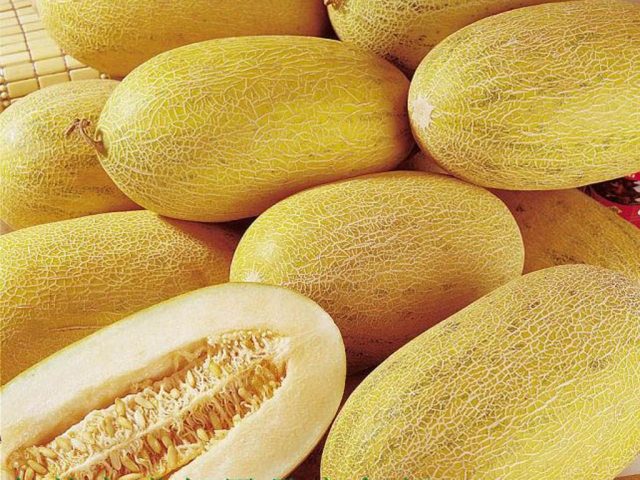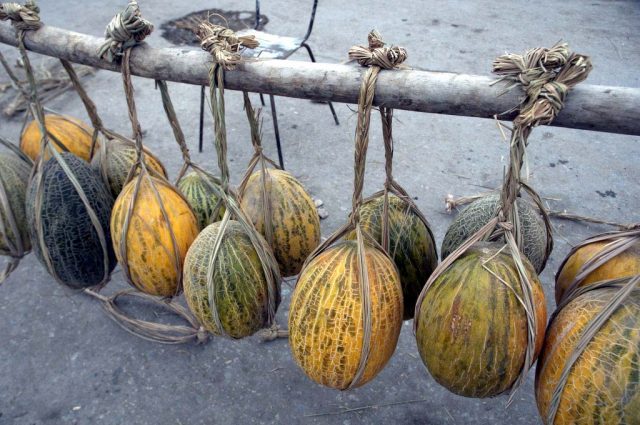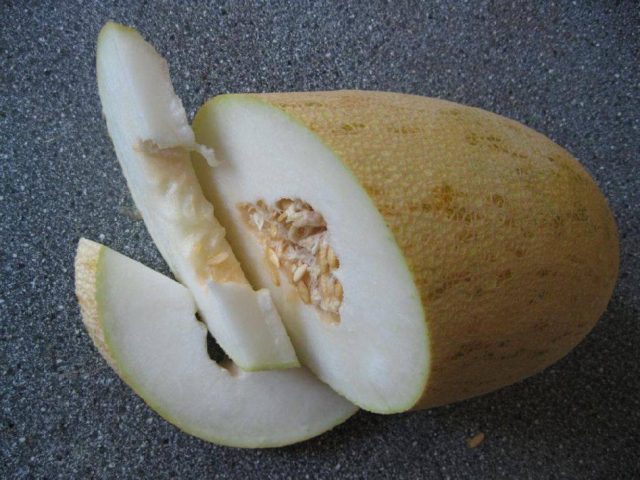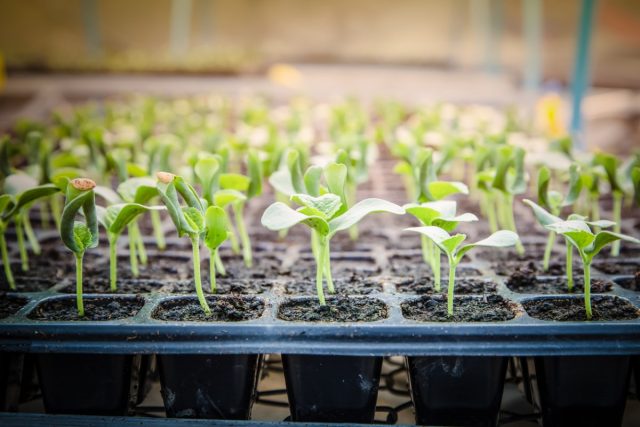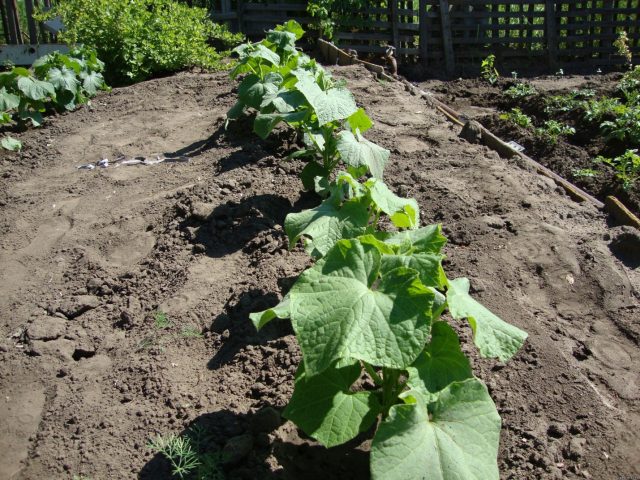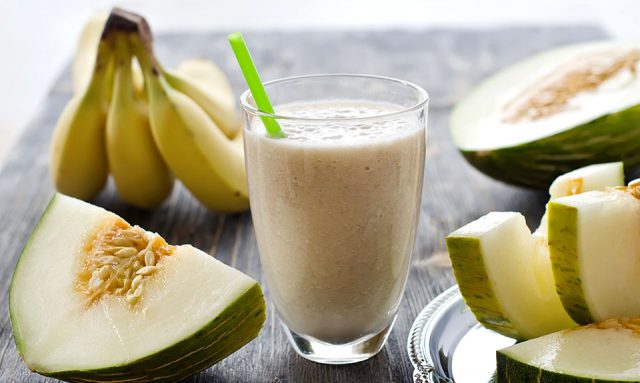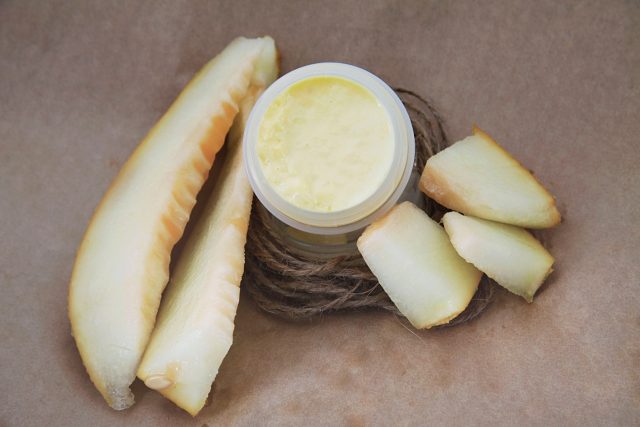Content
- 1 Description of Uzbek Melon Torpedo
- 2 Pros and cons of the variety
- 3 What is useful torpedo melon for the body
- 4 How to choose a ripe torpedo melon
- 5 How many calories in a torpedo melon
- 6 Glycemic Index of Melon Torpedo
- 7 How to Grow Torpedo Melons
- 8 Harvesting
- 9 Diseases and pests
- 10 Using Melon Torpedo
- 11 Contraindications
- 12 Conclusion
Melon Torpedo is one of the most popular representatives of sweet melons on domestic shelves. In the homeland of the variety, in Uzbekistan, it is called Mirzachulskaya, where the melon is cultivated in private farmsteads and in large areas for commercial purposes. The aroma and sweetness of the generous, southern sun combine with the high nutritional value and health benefits of melon. Yellow, fragrant fruits can be grown in temperate climates, but for this Torpedo will have to create some conditions.
Description of Uzbek Melon Torpedo
The annual melon culture, originating from Asia, appeared in Russia more than 300 years ago. Excellent transportability allowed the fruits of the torpedo melon to withstand long-term transportation, up to the territory of modern Europe. Today, the variety is not only imported for sale, but also grown in regions with warm and temperate climates.
Due to its characteristic oblong shape and large size, the sweet vegetable got its modern name, Torpedo. The official name of the variety is "Rainbow melon". The weight of the imported fruits of the Torpedo reaches 15 kg. The temperate climate of the middle zone allows individual specimens to grow up to about 5 kg.
The maximum length of torpedo melon shoots reaches 2 m. Young plant stems are strong and powerful. This allows you to grow the variety on supports to exclude contact of the lashes and fruits with the soil. This technique provides plant ventilation, disease prevention, and accelerates ripening.
Melon Torpedo has the following varietal characteristics:
- regular oval fruits grow from 0.3 to 0.5 m in length;
- the yellow rind is covered with a network of silvery veins;
- the pulp is milky, about 6 cm thick;
- the consistency is juicy, oily;
- a large number of seeds.
The taste of torpedo melon with sufficient sun and hot summer is assessed as excellent. In the middle lane, the sugar content of the fruit can be significantly reduced. Under favorable conditions, the melon acquires a bright aroma, rich taste with notes of pineapple, vanilla and duchess.
The torpedo belongs to the late varieties of melons and gourds. The term for reaching technical maturity in Central Asia is at least 60 days. Therefore, you should not expect a high-quality ripe product of this variety on the shelves before August.
Pros and cons of the variety
Melon Torpedo, judging by the photos and reviews of domestic gardeners, is capable of bearing excellent fruits in a temperate climate. Their mass is less, the smell and taste are somewhat inferior to the product from Asia, which is considered a relative disadvantage of the variety. Sometimes the melon does not have enough warm days, and it does not have time to fully ripen.
Comparable in popularity with the European variety Kolkhoznitsa, the Torpedo has the following advantages:
- excellent marketability and taste;
- transportability and keeping quality of fruits;
- health benefits of pulp and seeds.
Torpedo is one of the few melons and gourds that can be stored for a long time under certain conditions. In a cellar or cool room, melons stay fresh until spring. For this, fruits are selected at the stage of technical maturity and stored, suspended on supports.
What is useful torpedo melon for the body
The rich chemical composition of the fruits, the abundance of vitamins, microelements, biologically active compounds makes it possible to classify the melon as a health-improving product. The most useful substances in the torpedo pulp:
- vitamins E, C, A, PP representatives of the entire group B;
- potassium, chlorine, sodium are found in high concentrations;
- less, but therapeutically significant presence of potassium, magnesium, iron, fluorine, iodine;
- organic acids: pantothenic, malic, citric;
- vegetable fiber.
The sweet taste and unique balance of substances produce the following effects on the body:
- production of the hormone of happiness, reduction of anxiety;
- increase in general tone, decrease in apathy;
- improved blood count;
- strengthening of immunity.
How to choose a ripe torpedo melon
Among the wide variety of melons offered at the end of summer and autumn, I would like to choose the most ripe product. Melon Torpedo reveals its full varietal qualities only when fully ripe, harvested at the natural time for the variety, without ripening with the help of chemical dressings.
Signs of a ripe, quality melon:
- The surface of the fruit is dry and clean, without spots, cuts, or breaks.
- The color is uniform, yellow, without green streaks, brown areas.
- The melon is firm, but not hard. The peel is springy, does not squeeze when pressed with a finger.
- The smell is honey, intense, without sour notes.
- The tail is dry but strong.
Self-ripening torpedo melons do not appear on sale until the end of August. Fruits that are too early may contain substances that accelerate ripening and will not benefit the body.
How many calories in a torpedo melon
The calorie content of torpedo melon is one of the highest among melons, but its nutritional value does not exceed the limits of a dietary product. A sweet vegetable is allowed to eat even if you are overweight. The melon contains 90% water, in which nutrients and sugars are dissolved. Therefore, ripe pulp easily quenches thirst.
The Torpedo variety is the sweetest of the melons. The calorie content of 100 g of its pulp exceeds 35 kcal. Carbohydrates occupy the largest share in the composition - up to 7.5 g. Fats and proteins are present minimally, not exceeding 1 g in total.
Glycemic Index of Melon Torpedo
The high content of carbohydrates in Torpedo is compensated by their rapid absorption. "Fast sugar" is easily converted into energy, which means that it is completely consumed by the body. On this basis, the torpedo melon can be called a natural energetic.
Easily digestible carbohydrates have the ability to jump in blood sugar levels, which later drop on their own. People with diabetes should be aware of this effect. The glycemic index of Torpedo melon is quite high and amounts to 65 units, which is 10 points less than that of ripe watermelons.
Rules for the use of torpedo melon for diabetics:
- With type 1 diabetes, it is allowed to include a sweet vegetable in the diet on general principles.
- In type 2 diabetes with concomitant obesity, eating fruit is beneficial for weight loss. When using melon, it's worth keeping a close eye on your blood sugar levels.
- The main rule is full compensation of consumed carbohydrates with drug insulin and regular physical activity.
Melon Torpedo contains few calories and can be used for dietary nutrition. Due to the energy and vitamin composition, the Torpedo variety is indicated for recovery from serious illnesses, as a useful product for athletes or in case of rapid physical fatigue.
How to Grow Torpedo Melons
The heat-loving torpedo melon is a southern plant, its cultivation in the middle lane is fraught with difficulties.Due to the lack of light and heat, the ripening periods of melons are stretched, and the fruits do not have time to ripen. Therefore, in temperate climates, the Torpedo variety is recommended to be grown in greenhouses or greenhouses.
Planting the Torpedo variety with seeds directly into open ground is permissible in areas with warm summers.
Basic landing rules:
- The soil temperature during work should not be lower than + 14 ° C, otherwise the seedlings will be rare and weak.
- Before planting, melon seeds are soaked to swell and discard non-similar specimens.
- The hatched seeds are buried 5-6 cm into the ground, placing 4-5 seeds in each hole.
- The torpedo melon sowing scheme is chosen arbitrarily, maintaining the distance between the holes from 60 to 100 cm.
In most of the territory of Russia, the climate does not allow getting a full harvest of Torpedo melon without shelter. To ensure a complete growing season, the variety is grown through seedlings.
Seedling preparation
Before planting seeds for seedlings, they are sorted, etched in a slightly pink solution of potassium permanganate, and sprouts are waited for. The sunken seeds are ready to be embedded in the ground.
The choice of containers for planting is dictated by some conditions:
- The fragile root system of the sprouts is easily damaged during transplantation, so peat tablets or glasses are used for melons.
- The size of the planting containers is chosen based on the expected planting time: in peat tablets, plants can develop for up to 14 days, in glasses, seedlings can expect planting for a month.
- It is permissible to plant several seeds in pots more than 10 cm deep. Grown plants are evaluated for strength, stature and leave one, cutting off excess stems.
- In the middle lane, Torpedo seeds are sown from the end of April, and they are brought out to the beds by June.
You can prepare the soil mixture for melons yourself by mixing in equal parts garden soil, peat, sand and humus.
The process of growing torpedo melon seedlings:
- the soil is moistened by adding complex fertilizers to the water, suitable for pumpkin crops;
- the seeds are buried into the substrate by 1-2 cm;
- sprinkle the surface of the soil with sand to prevent rot and black leg;
- contain pots at a temperature not lower than + 20 ° C (night fluctuations up to + 15 ° C are permissible);
- watering is carried out in moderation, focusing on the drying out of the topsoil.
After waiting for favorable weather conditions, they take out the Torpedo seedlings outside and harden them for several days.
Selection and preparation of the landing site
Gray forest, sandy loam soils and black soil are the best soils for Torpedo melon. Any other types of substrates will have to be adjusted to the needs of melons. In any case, the acidity of the soil in the beds should be neutral.
Melons need an abundance of light and warmth, therefore, places open to the sun are allocated for them. The night temperature should not drop below + 15 ° C. It is advisable to protect the site from winds and drafts with tall plants or a small fence. On beds with melons of the southern Torpedo variety, stagnation of moisture, provoking rot and fungal infections, is unacceptable.
Supplementary lighting in the greenhouse is carried out with an intensity of 5000-6000 lux. For a torpedo melon in a protected ground, it is enough to create a layer of fertile soil up to 15 cm thick. The substrate is mixed based on the ratio: 1 part of peat and sand to 2 parts of humus.
It is advisable to prepare open beds for melons in the fall:
- Dig up the soil to a depth in the bayonet of a shovel.
- Organic matter is introduced: 5 kg of mature manure or humus per 1 sq. m.
- Sand is introduced into loamy soils, providing a looseness of the substrate.
In the spring, the melon site is fertilized with potash-phosphorus complex compounds. On the prepared beds, future holes are planned and the soil warms up.
Landing rules
Adult seedlings of Torpedo melon are ready for transplanting 35 days after the first shoots appear. The best specimens by this time grow 6-7 true leaves.
The standard layout of the holes involves leaving 60 cm between plants, 80 cm between rows, about 1 m in the aisles.
The soil in the beds is abundantly moistened, young plants are placed in the holes, and the root ball is sprinkled with soil. In this case, the neck of the melon should not be buried more than that of the seedlings before planting. It is useful to mulch the surface of the soil with river sand. When the weather is unstable, they arrange film shelters for the beds.
Watering and feeding
After planting the seedlings of the Torpedo, until its very rooting, moistening is carried out with heated water. When the plants start to grow, the number of watering is reduced until they stop completely. Before the formation of melon ovaries, the torpedo is rarely watered, only with a strong drying out of the soil, preventing excess tops from growing.
Irrigation is intensified after fruit formation, when melons are gaining weight. About 4 weeks before the intended harvest, watering is reduced again. This technique provides the Torpedo variety with a set of sugars and the appearance of a typical melon aroma.
Even in well-prepared beds, melons need abundant fertilization. During the season, at least 3 additional fertilizing will be required:
- 15 days after planting, add 2 liters of ammonium nitrate solution per bush (20 g of the drug per 10 liters of water).
- The same technique is repeated during melon flowering.
- The last feeding is done 20 days after budding: 25 g of phosphorus and potassium fertilizers are diluted with 10 liters of water and 2 liters of liquid are added under 1 bush.
After the tops are closed, feeding is stopped. Fertilization is unacceptable if less than 20 days remain before harvesting.
Formation
There are two popular methods of forming Torpedo bushes: trellis and spreading. In the open air, most often, the plant is allowed to travel freely along the ground. For this method, the central shoot of the Torpedo should be pinched over 4 more leaves and the lateral processes should be allowed to develop, which are left no more than 3 pieces.
Long shoots are pinned to the soil to form additional roots. This technique provides increased nutrition for the Torpedo fruits.
In greenhouse conditions or to save space on the site, melons are formed vertically:
- arrange two horizontal trellises at a height of 2 m above the beds;
- a week after planting the seedlings, tie one shoot to each of the trellises;
- as the central stem and lateral lashes grow, adjust their length by pinching, remove the processes without ovaries;
- after the first fruits of the Torpedo reach a diameter of 5 cm, remove excess ovaries throughout the bush;
- 6-7 melons can grow and ripen at the same time on one bush, the rest of the ovaries will weaken the bush, which will affect the quality of the crop.
With the method of forming, roofing material, slate, garden non-woven material are underlayed under the fruits and part of the lashes. This will keep the melons and stems from getting too hot.
Harvesting
For transportation and subsequent sale, Torpedo fruits are harvested at the stage of technical ripeness. When growing for personal use, it is important to select a ripe melon in the garden and leave the remaining fruits to ripen naturally.
The ripeness level of the Torpedo melon is determined by the following criteria:
- The fruit is easily detached from the stem without twisting movements.
- The color of the peel is bright, uniform on all sides.
- Rings are clearly visible around the stalk.
- Melon exudes a bright, honey aroma.
Diseases and pests
The main cause of melons and gourds diseases in temperate climates is the high humidity of the air and soil, which is unusual for southern crops. Fungal, bacterial, viral types of infection of leaves and fruits with excessive watering or excess rainfall are widespread. Against the background of waterlogging, the Torpedo variety quickly develops root rot.
Typical diseases of melons:
- anthracnose;
- peronosporosis;
- powdery mildew;
- fusarium wilting.
For the prevention of these diseases, seeds and soil must be disinfected, and crop rotation is observed. Weeds in the beds contributes to the infestation of melons, so the soil on the melon should be kept clean until the leaves close.
With early detection of infections, spraying the plantings of torpedo melons with a 1% solution of copper sulfate helps. If ineffective, treatment with specialized drugs will be required.
In the middle lane, the landings of the Torpedo are threatened by the following insects:
- melon fly, which spoils ripe fruits;
- spider mite - affects the leaves;
- gnawing scoops - suck out the juice of the stems.
On weed-free beds without excess moisture and with proper soil preparation, from autumn the danger of insect attacks on the Torpedo plantings is noticeably reduced. If the infection could not be avoided, a special insecticide is selected from a specific type of pest.
Using Melon Torpedo
The benefits and harms of torpedo melon are determined by its rich composition, which ensures the widespread use of juicy pulp, seeds and even peel. The fruits are eaten, used for skin, hair and are included in the treatment for certain diseases.
In cooking
Melon Torpedo is eaten fresh, jam and compotes are made from it, juice is squeezed, aromatic substances are extracted to enrich many dishes and drinks. Candied fruits are prepared from the peel of the vegetable.
Nutritionists recommend including the seasonal vegetable in wellness diets along with fruit. There are special "melon" diets that make it easy to lose weight. Fasting days using only Torpedo pulp are allowed twice a week.
In cosmetology
Torpedo melon seeds contain zinc in significant concentrations. This substance has a beneficial effect on the condition of the skin, strengthens the hair. In addition to this effect, the internal intake of Torpedo seeds with honey contributes to the healing of the whole body, enhances immunity, and increases libido.
As part of professional cosmetic products, the Torpedo melon variety exhibits the following properties:
- prevents early skin aging;
- whitens, evens out the complexion;
- provides nutrition and hydration of cells.
At home, it is easy to use all these properties of melon, simply by applying gruel from the pulp of the Torpedo to problem areas of the skin, nail plates, hair. For bleaching age spots, removing freckles, mashed fruits are also used.
A mixture of melon and olive oil perfectly nourishes and moisturizes tired skin of the face and hands for a long time. Take 1 tbsp. l. oil for 4 tbsp. l. pulp, mix and apply as a mask. After the procedure, the skin becomes velvety, smooth and taut.
To restore damaged hair, you can use this home recipe:
- ground pulp of torpedo melon - 100 g;
- burdock oil - 1 tbsp. l .;
- the yolk of one egg.
Combine all ingredients and beat until smooth. Apply to the scalp, spread over the strands.Leave to act for at least 15 minutes. Wash off with warm water and a gentle shampoo. Enough 4 procedures once a week to restore brittle, dried or damaged hair.
In folk medicine
Useful properties of Torpedo fruits are used as an additional remedy in such conditions:
- anemia;
- excess of the norms of cholesterol in the blood;
- hypertension;
- toxicosis and poisoning;
- kidney stones and sand.
The presence of a large amount of vegetable fiber in combination with other beneficial substances promotes gentle bowel cleansing, binds and removes toxins, improves peristalsis.
In case of disorders in the work of the heart, torpedo melon is a source of valuable compounds that feed the myocardium. In the absence of contraindications, the vegetable can be used in dietary nutrition for angina pectoris, endocarditis, ischemic heart disease, atherosclerosis and other pathological conditions.
Contraindications
The use of torpedo melon is contraindicated for such diseases:
- severe diabetes mellitus;
- the presence of ulceration in the gastrointestinal tract;
- intestinal dysbiosis;
- dysentery.
Melon is used with caution when drawing up the diet of nursing mothers. Substances that enter breast milk can cause flatulence and colic in the infant.
Melon Torpedo does not go well with dairy products, alcohol, chilled drinks. For any abnormalities in the work of the stomach, it is not recommended to eat the fruits on an empty stomach.
Conclusion
Melon Torpedo is a southern, sweet vegetable that has long ceased to be exotic even for residents of the northern regions. The geography of cultivation of the variety is shifting farther north every season. Special agricultural practices, the use of fertilizers, modern greenhouses and hotbeds make it possible to obtain solar melons in an atypical climate for them.
